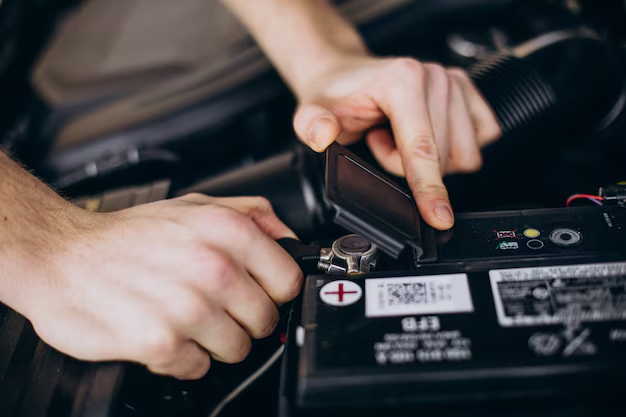How to Read an Amp Meter on a Battery Charger
Understanding how to read an amp meter on a battery charger is an essential skill for anyone who uses rechargeable batteries. Whether you’re charging a car battery, a marine battery, or a deep-cycle battery for a trolling motor, an amp meter provides critical information about the charging process. This guide will walk you through the basics of amp meters, how to interpret their readings, and what they reveal about your battery’s health and charging status.
1. What Is an Amp Meter?
An amp meter, short for ammeter, is an instrument used to measure electric current in amperes. On a battery charger, the amp meter displays the amount of current flowing into the battery during charging. This information is vital because it helps you monitor the charging process and avoid overcharging or undercharging the battery.
A battery charger is used to put energy into a rechargeable battery by delivering current through it. On the other hand, a battery amp meter indicates the battery charger’s current delivery to the battery. A battery charger amp meter shows the state of charge as the battery is being charged. Reading a battery charger will give the battery an extended life. It prevents overcharging of the battery, helps you calculate the current delivered to the battery, and indicates the amount of current delivered by the battery charger to your battery.
Amp meters on battery chargers typically feature a scale with markings that indicate the charging rate. The readings fluctuate based on the battery’s state of charge, condition, and the charger’s settings.
2. Understanding the Components of an Amp Meter
To read an amp meter effectively, it’s important to understand its key components:
- Scale: The scale shows the range of current the amp meter can measure, often in increments of 2, 5, or 10 amps.
- Needle or Digital Display: The needle (in analog meters) or digital readout indicates the current level.
- Markings: The scale may include specific markings, such as “charge,” “boost,” or “full,” to guide users.
- Zero Point: This is the starting point of the meter, usually on the far left.
An amp meter is similar to a voltmeter only that a voltmeter measures the voltage between two points in a circuit. You should be careful when buying an amp meter, so you do not confuse it with a voltmeter.
3. Types of Amp Meters Used in Battery Chargers
There are different types of amp meters used in battery chargers. Three types of amp meters are commonly used:
- Direct Current (DC) Amp Meters: These measure the direct current flowing into the battery.
- External Shunt Type Meters: These require an external shunt to measure the current.
- Meter Mounted Shunt Type: These have the shunt integrated into the meter for ease of use.
All these types indicate the charging rate of the battery and help ensure accurate monitoring of the charging process.
4. How to Read an Amp Meter on a Battery Charger
Follow these steps to accurately read the amp meter on your battery charger:
Step 1: Connect the Charger to the Battery
- Ensure the battery charger is turned off.
- Connect the positive (red) clamp to the positive terminal of the battery.
- Connect the negative (black) clamp to the negative terminal.
- Turn on the charger and select the appropriate charging mode (e.g., slow charge or fast charge).
Step 2: Observe the Initial Reading
Once the charger is turned on, the amp meter will display an initial reading. This number indicates the amount of current flowing into the battery. For a deeply discharged battery, the reading will typically be higher because the charger is working harder to replenish the battery’s capacity.
- Example: If the amp meter reads 10 amps, it means 10 amperes of current are being delivered to the battery.
Step 3: Monitor the Reading Over Time
As the battery charges, the amp meter reading will gradually decrease. This is a normal part of the charging process. A lower reading indicates that the battery is nearing full charge and requires less current.
- Key Insight: If the amp meter remains high for an extended period, it could signal an issue with the battery, such as sulfation or internal damage.
Step 4: Interpret the Final Reading
When the amp meter needle drops close to zero (or a low value on a digital meter), the battery is fully charged. Some chargers have an automatic shutoff feature that stops charging at this point.
5. What Do Different Amp Meter Readings Mean?
Here’s a breakdown of common amp meter readings and what they signify:
- High Reading (e.g., 10-15 amps):
- The battery is deeply discharged, and the charger is delivering maximum current.
- This is normal at the start of the charging cycle.
- Moderate Reading (e.g., 5-8 amps):
- The battery is partially charged.
- The charger is reducing current as the battery’s voltage increases.
- Low Reading (e.g., 1-3 amps):
- The battery is nearly full, and the charger is in a “trickle charge” mode.
- Zero Reading:
- The battery is fully charged, or the charger is not delivering current.
- Check the connections if the battery isn’t expected to be fully charged yet.
6. Tips for Effective Use of an Amp Meter
To get the most out of your amp meter and battery charger, follow these tips:
- Match the Charger to the Battery: Use a charger that is compatible with your battery type and voltage. Overloading the battery with excessive current can cause damage.
- Monitor the Entire Charging Process: Periodically check the amp meter to ensure the battery is charging as expected.
- Understand Trickle Charging: Some chargers switch to a low-current trickle charge when the battery is almost full. This is normal and helps maintain the battery without overcharging.
- Inspect the Battery: If the amp meter shows irregular readings (e.g., fluctuating wildly or staying high), inspect the battery for signs of damage, such as corrosion or swelling.
- Keep the Amp Meter Clean: For analog meters, ensure the glass covering is clean and free from scratches to make readings easier to see.
7. Common Problems and Troubleshooting
If you’re having trouble interpreting your amp meter readings, consider these common issues:
- Meter Stays at Zero:
- Check the connections and ensure the clamps are securely attached to the battery terminals.
- Verify that the charger is powered on and functioning.
- High Reading That Doesn’t Drop:
- This could indicate a problem with the battery, such as sulfation or internal short circuits.
- Try using a desulfation charger to revive the battery.
- Unsteady or Fluctuating Readings:
- Ensure the charger and amp meter are functioning properly.
- Check for loose connections or damaged cables.
8. Safety Considerations
Using a battery charger involves handling electrical equipment, so it’s important to prioritize safety:
- Work in a Well-Ventilated Area: Charging batteries can release hydrogen gas, which is flammable.
- Wear Protective Gear: Use gloves and safety glasses to protect against acid spills or sparks.
- Avoid Overcharging: Always monitor the amp meter and use a charger with an automatic shutoff feature if possible.
- Disconnect Properly: Turn off the charger before removing the clamps to avoid sparks or electrical shocks.
9. Conclusion
Learning how to read an amp meter on a battery charger is a valuable skill that ensures your batteries are charged safely and effectively. By understanding the amp meter’s readings, you can monitor the charging process, identify potential issues, and maintain the longevity of your batteries. Whether you’re a seasoned mechanic or a casual boater, mastering this skill will give you confidence in managing your battery systems.
So, next time you connect your battery charger, take a moment to observe the amp meter—it’s your window into the health and status of your battery.
FAQs About Battery Chargers and Amp Meters
How many amps should a battery charger read?
The amps a battery charger should read depend on the charger’s capacity and the type of battery being charged. Most battery chargers for car batteries typically output between 2 to 10 amps. A lower amp reading (e.g., 2-5 amps) indicates a slow charge, while a higher reading (e.g., 10 amps or more) signifies a faster charge. However, using a charger with a higher amp rating than recommended for the battery can damage it over time. Always check the battery’s specifications for the ideal charging rate.
What does the amp meter mean on a battery charger?
The amp meter on a battery charger shows the amount of current (in amps) being delivered to the battery during charging. When the battery is low or heavily discharged, the amp meter will display a higher reading as the charger works to replenish the battery. As the battery charges and approaches full capacity, the amp meter reading will gradually decrease, indicating reduced current flow. If the needle or display stays low from the beginning, it could mean the battery is already charged or there is an issue with the charger or battery.
How do you read a battery amp?
To read a battery’s amp draw or charge, follow these steps:
- Use an Amp Meter: Connect an amp meter or multimeter in series with the circuit or battery.
- Select the Correct Setting: Set the meter to measure DC amps within the appropriate range for your battery.
- Read the Display: The meter will show the amperage being drawn by a load (discharge) or delivered by a charger (charge).
- Observe Changes: For charging, a higher reading indicates a faster charge. A lower reading means the battery is nearing full charge.
How to test battery charger amp output?
To test the amp output of a battery charger:
- Use a Multimeter: Set the multimeter to the DC amperage setting.
- Connect the Multimeter: Attach the multimeter probes in series with the charger’s output and the battery or a load. Ensure proper polarity (red to positive, black to negative).
- Turn On the Charger: Power on the charger and observe the multimeter reading. This will display the actual amperage being output by the charger.
- Compare to Rating: Compare the measured amp output to the charger’s stated specifications. If the reading is significantly lower, the charger may be faulty or the battery may be near full charge.





